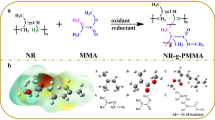Abstract
Natural rubber latex (NRL) films have high elasticity and flexibility and are excellent protection barriers against micro-organisms. For this reason, NRL is often used in the manufacture of medical products, such as gloves, condoms, blood transfusion tubes and catheters. The objective of this study was to evaluate the effect of two accelerators, ZDEC and TMTD, of the sulphur-based curing system, on the rheometric, crosslink density, thermal and mechanical properties. For this purpose, the compositions of NRL films were designed using two-level factorial design with a centre point, considering the variation from − 1 to + 1 of the levels of sulphur and accelerators. The results indicated that the delta torque was influenced by the addition of sulphur only. Scorch time (Ts1) and optimum vulcanization time (T90) decreased as TMTD was added to the formulations. TMTD only contributed to the crosslink density when low amounts of sulphur were used. Higher values of tensile strength were observed for sulphur, ZDEC and TMTD amounts, but it was close to the centre point experiments. SEV and EV vulcanization systems did not necessarily produce crosslinks that require higher energy to brake when compared to CONV system.







Similar content being viewed by others
Data Availability
The raw/processed data required to reproduce these findings cannot be shared at this time as the data also forms part of an ongoing study.
References
Cornish K (2014) Biosynthesis of natural rubber (NR) in different rubber-producing species. In: Chemistry, manufacture and applications of natural rubber. Chemistry, manufacture and applications of natural rubber. Woodhead Publishing, pp 3–29. https://doi.org/10.1533/9780857096913.1.3
Modi SJ, Cornish K, Koelling K, Vodovotz Y (2016) Fabrication and improved performance of poly(3-hydroxybutyrate-co-3-hydroxyvalerate) for packaging by addition of high molecular weight natural rubber. J Appl Polym Sci 133:1–9. https://doi.org/10.1002/app.43937
Guidelli EJ, Ramos AP, Zaniquelli MED, Baffa O (2011) Green synthesis of colloidal silver nanoparticles using natural rubber latex extracted from Hevea brasiliensis. Spectrochim Acta Part A Mol Biomol Spectrosc 82:140–145. https://doi.org/10.1016/j.saa.2011.07.024
Keddie JL (1997) Reports: a review journal film formation of latex. Mater Sci Eng 21:101–170. https://doi.org/10.1016/S0927-796X(97)00011-9
Sornsanee P, Jitprarop V, Tangboriboon N (2018) Preparation polyisoprene (NR) and polyacrylonitrile rubber latex glove films by dipping ceramic hand molds process and their properties. Defect Diffus Forum 382:21–25. https://doi.org/10.4028/www.scientific.net/DDF.382.21
Chen M, Ao NJ, Zhang BL et al (2005) Comparison and evaluation of the thermooxidative stability of medical natural rubber latex products prepared with a sulfur vulcanization system and a peroxide vulcanization system. J Appl Polym Sci 98:591–597. https://doi.org/10.1002/app.22047
Pojanavaraphan T, Schiraldi DA, Magaraphan R (2010) Mechanical, rheological, and swelling behavior of natural rubber/montmorillonite aerogels prepared by freeze-drying. Appl Clay Sci 50:271–279. https://doi.org/10.1016/j.clay.2010.08.020
Choi SS, Kim E (2015) A novel system for measurement of types and densities of sulfur crosslinks of a filled rubber vulcanizate. Polym Test 42:62–68. https://doi.org/10.1016/j.polymertesting.2014.12.007
Mitra A, Leonov AI (2010) On rheology, cure kinetics and chemorheology of gum rubbers. Polym Sci Ser A 52:1114–1123. https://doi.org/10.1134/S0965545X10110052
Thomas S, Aldlyami E, Gupta S et al (2011) Unsuitability and high perforation rate of latex-free gloves in arthroplasty: a cause for concern. Arch Orthop Trauma Surg 131:455–458. https://doi.org/10.1007/s00402-010-1146-8
Nunes F, Kersch M, Niebergall U et al (2017) Effect of different sulphur-based crosslink networks on the nitrile rubber resistance to biodiesel. Fuel 191:130–139. https://doi.org/10.1016/j.fuel.2016.11.060
Boonkerd K, Deeprasertkul C, Boonsomwong K (2016) Effect of sulfur to accelerator ratio on crosslink structure, reversion, and strength in natural rubber. Rubber Chem Technol 89:450–464. https://doi.org/10.5254/rct.16.85963
Palaty S, Joseph R (2001) Studies on xanthate–zinc diethyl dithiocarbamate accelerator combination in natural rubber. Plast, Rubber Compos 30:270–274. https://doi.org/10.1179/146580101101541697
Ibrahim SZ, Mohd CHE, Said SOM et al (2016) Preliminary study on curing of thick rubber article. Advanced Materials Research 1134:23–27. https://doi.org/10.4028/www.scientific.net/AMR.1134.23
Moon B, Lee J, Park S, Seok CS (2018) Study on the aging behavior of natural rubber/butadiene rubber (NR/BR) blends using a parallel spring model. Polymers (Basel). https://doi.org/10.3390/polym10060658
Flynn Law JH (1966) A quick, direct method for the determination of activation energy from thermogravimetric data. Polym Lett 4:323–328. https://doi.org/10.1017/CCOL0521840643.004
Ozawa T (1970) Kinetic analysis of derivative curves in thermal analysis. J Therm Anal 2:301–324. https://doi.org/10.1007/BF01911411
Jin-zong Y, Cheng-jie W, Xue-jie W (2018) The thermal decomposition mechanism and kinetics of tenoxicam. J Anal Appl Pyrolysis. https://doi.org/10.1016/j.jaap.2018.08.006
Jana GK, Das CK (2005) Devulcanization of natural rubber vulcanizates by mechanochemical process. Polym Plast Technol Eng 44:1399–1412. https://doi.org/10.1080/03602550500209853
Albano C, Hernández M, Ichazo MN et al (2011) Characterization of NBR/bentonite composites: vulcanization kinetics and rheometric and mechanical properties. Polym Bull 67:653–667. https://doi.org/10.1007/s00289-010-0432-5
Khang TH, Ariff ZM (2012) Vulcanization kinetics study of natural rubber compounds having different formulation variables. J Therm Anal Calorim 109:1545–1553. https://doi.org/10.1007/s10973-011-1937-3
Sun X, Isayev AI (2009) Cure kinetics study of unfilled and carbon black filled synthetic isoprene rubber. Rubber Chem Technol 82:149–169. https://doi.org/10.5254/1.3548241
de Arruda MMS, Cunha LMG, Visconte LLY et al (2019) Behavior of zinc complex of bis (N-phenylsulfonyldithiocarbimate) as accelerator in the vulcanization of nitrile rubber compounds. J Appl Polym Sci 136:47211. https://doi.org/10.1002/app.47211
Diaz R, Colomines G, Peuvrel-Disdier E, Deterre R (2018) Thermo-mechanical recycling of rubber: relationship between material properties and specific mechanical energy. J Mater Process Technol 252:454–468. https://doi.org/10.1016/j.jmatprotec.2017.10.014
Acknowledgements
The authors wish to thank Teadit and Masterbor for donating the materials, Nitriflex for the use of its facilities, Conselho Nacional de Desenvolvimento Científico e Tecnológico (CNPQ) for the research supporting and Coordenação de Aperfeiçoamento de Pessoal de Nível Superior (CAPES) for the for financial supporting (Financing code 001).
Author information
Authors and Affiliations
Corresponding author
Additional information
Publisher's Note
Springer Nature remains neutral with regard to jurisdictional claims in published maps and institutional affiliations.
Rights and permissions
About this article
Cite this article
de Lima, D.R., da Rocha, E.B.D., de Sousa, A.M.F. et al. Effect of vulcanization systems on the properties of natural rubber latex films. Polym. Bull. 78, 3943–3957 (2021). https://doi.org/10.1007/s00289-020-03291-4
Received:
Revised:
Accepted:
Published:
Issue Date:
DOI: https://doi.org/10.1007/s00289-020-03291-4




